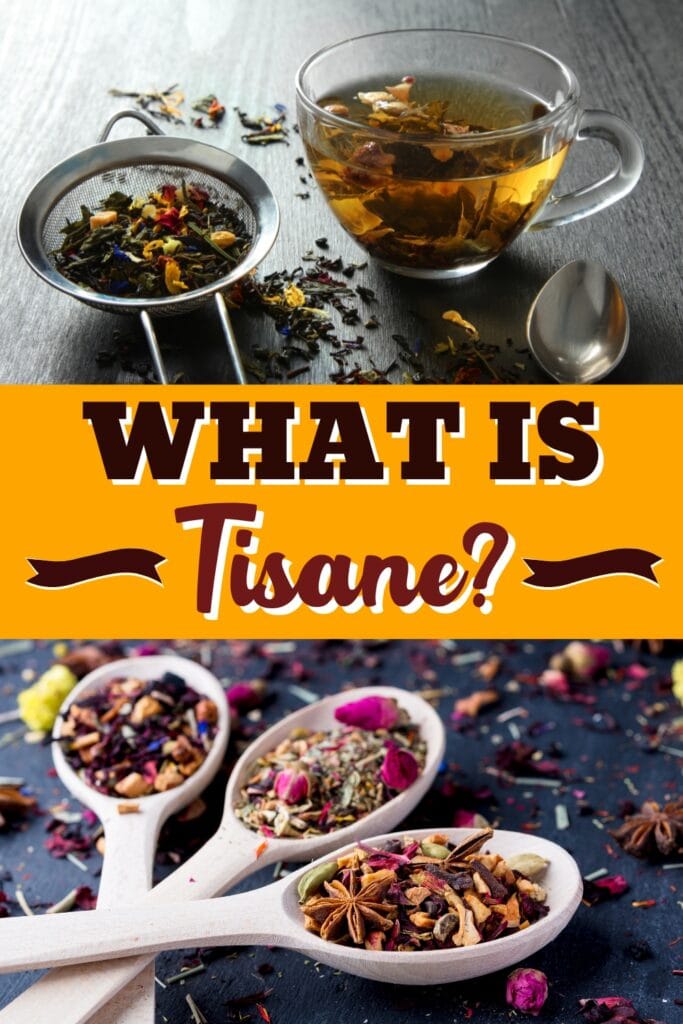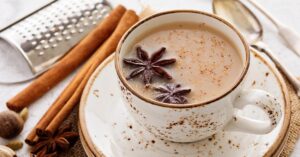If you love herbal teas, you might have found yourself wondering “What is tisane?”
There’s plenty to ‘ooh’ and ‘ahh’ about when it comes to tisanes!
Not only are they super comforting, but their amazing health benefits are fantastic when you’re feeling under the weather

From calming effects of classic chamomile to the rejuvenating feeling of fragrant lavender, there’s a tisane out there for everyone.
They’re a great way to indulge in some self-care. And they’re way cheaper than a trip to the spa!
So, grab your favorite mug, get cozy, and get sipping.
What Is Tisane?
The name may sound a little fancy, but tisane is just a cool name for herbal tea.
And get this, herbal tea isn’t actually tea at all!
It’s actually an infusion of herbs, spices, and fruits steeped in hot water.
All those amazing aromas steep together to create the most amazing combo of flavors.
From classic chamomile and mint to more exotic blends like hibiscus and rosehip, there is such a huge variety of tisanes to choose from.
Not a fan of milky teas? Tisane is your new best friend!
Tisanes have been brewed for centuries.
They’re so good, ancient civilizations like the Greeks and Egyptians used them for their medicinal properties.
In fact, cultures all around the world still rely on tisanes for their health benefits.
They’re a great natural remedy for things like the flu, insomnia, and anxiety.
So, the next time you’re feeling under the weather, you know what to do.
But it’s not just about the health benefits. Let’s not forget that tisanes are downright delicious, too!
Plus, they’re often caffeine-free, making them the perfect late-night indulgence. It’s a win-win!

Types of Tisanes
There’re five different types of tisane, all from different parts of the plant.
- Leaf Tisane: These tisanes are made from plants like peppermint, chamomile, Moringa leaves, and lemon verbena.
Mint tisanes also fall under this category. They’re especially popular for their wonderful soothing properties.
Yerba mate or Rooibos are two tisanes that taste pretty similar to tea. they come from a bushy shrub in South Africa.
And fun fact: Yerba mate is the only caffeinated tisane!
- Flower Tisane: These are a lot more fragrant and aromatic. Plants like hibiscus and lavender have a lovely herbaceous, almost vegetal-like taste rather than a perfumed one.
Their aroma really brings out the flavor in a tisane.
- Fruit/Berry Tisane: Sweet and caffeine-free, fruit tisanes are perfect for any time of day. They’re made from a blend of spices, fruits, and herbs, the most popular being hibiscus.
Raspberry leaf is also a popular fruit-tisane ingredient.
You can even add citrus rinds like lemon or orange to brighten up the flavor.
Want to get really fancy? Throw in some herbs and roots, too!
- Toasted Grain Tisane: Toasted whole grains like barley create a more mild flavor.
You can add lemon, sugar, or lime juice to create an agua de cebada (barley water) tisane.
Just don’t forget to toast the grains before you add them to the drink! That way, they release all their wonderful natural oils!
- Seed/Spice and Roots Tisane: Spices like cardamom, cinnamon, and cloves add so much flavor to tisane. But be careful! Adding too much might make it a little bitter.
You can balance out the spices with some crushed fennel seeds, star anise, or licorice.
This creates the most amazing, harmonious flavor.
Tisane vs. Tea (What’s the Difference?)
They may look and taste pretty similar, but tisane and tea are actually two different things.
It all comes down to these two major differences:
- Plant Origin: Regular, true tea is made from the leaves of the Camellia Sinensis plant, which belongs to the Theaceae family.
Tisane, however, doesn’t come from this plant family. It’s typically made with a blend of different plant types or parts of the same plant.
- Caffeine Content: A regular cup of tea’s caffeine content depends on its type and origin.
But true tea, made from the Camellia Sinensis plant, has about 15-70 micrograms of caffeine per cup.
Just for reference, a cup of coffee has about 95 micrograms of caffeine in it.
So, it’s not a huge amount, but it’s enough to perk you up.
But tisane teas are completely caffeine-free. So, they’re a great option if you’re avoiding caffeine completely.

How to Make Tisanes
Tisanes are usually made as an infusion or decoction.
Don’t know the difference? Infusion is just a fancy way of saying “steeping” your plant parts (flowers, leaves, etc) in boiling water.
Decoction, on the other hand, involves putting your plants in boiling water and letting them steep for a bit.
That way, you get as much of the essential oils and flavor out as possible.
This method is great for tough plant parts with a smaller surface area like bark, root, and berry tisanes.
When it comes to brewing times and proportions, things can get a bit tricky.
Some tisanes only need a couple of minutes to brew, while others can need up to 15 minutes.
The amount of plant material you need can also vary.
Some tisanes only need a pinch, while others can use up to several tablespoons per cup of water.
Just be sure you follow the instructions for each type of tisane, and you’ll be good to go.
But if for some reason your tisane doesn’t have any instructions, no sweat!
Just ask your supplier or do a quick search online for the specific tisane you want to make.
And once you’ve got the basics down, feel free to adjust the quantities and brewing time to suit your tastes. Happy sipping!










